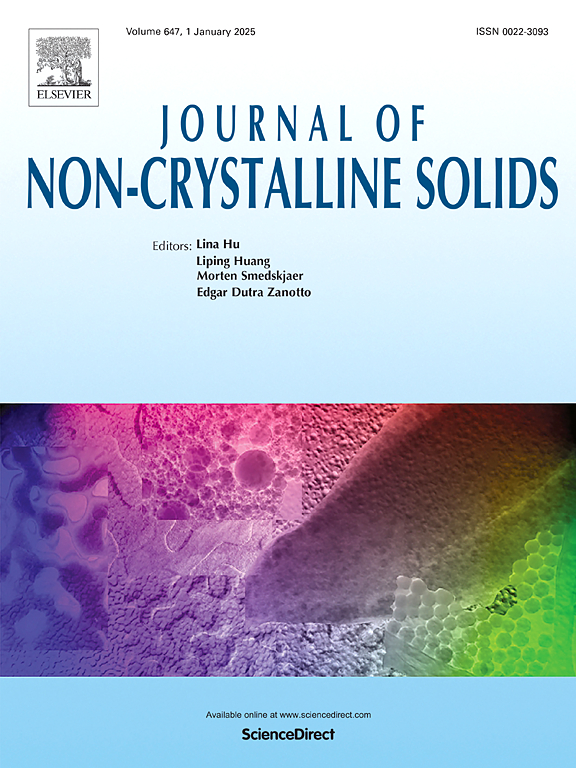稀土元素微合金化对FeCoSiBCuRE (RE = Sc and Y)非晶/纳米晶合金非晶形成能力和软磁性能的影响
IF 3.5
3区 材料科学
Q1 MATERIALS SCIENCE, CERAMICS
引用次数: 0
摘要
系统研究了稀土元素微合金化对FeCoSiBCuRE (RE = Sc和Y)非晶/纳米晶合金非晶形成能力、热稳定性和软磁性能的影响。把Nb换成3at。% Sc或Y显著改善了GFA,即使在铁含量高达84 at时也能形成完全无定形。%。Y或Sc的加入诱导了Fe3B亚稳相的额外结晶峰,Y微合金的结晶温度为850 ~ 860 K, Sc微合金的结晶温度为896 K。此外,退火温度窗分别降低了87 ~ 106 K和32 K,因此热稳定性减弱。结晶退火后合金的矫顽力(Hc)急剧增加,这是由于硬磁性Fe3B相过早析出和晶粒尺寸增大所致。相比之下,低于结晶温度的应力消除退火产生了具有极低Hc的主要非晶态结构。其中,(Fe0.8Co0.2)83Si1B12Cu1Sc3合金具有较好的磁性能,饱和磁通密度(Bs)高达1.66 T, Hc低至0.92 a /m。这一突出的性能归功于稀土诱导熔体净化,带状表面质量的改善,消除了畴壁钉钉位点,以及形成了单轴诱导磁畴结构。本文章由计算机程序翻译,如有差异,请以英文原文为准。
Effect of rare-earth elements microalloying on the glass-forming ability and soft magnetic properties of FeCoSiBCuRE (RE = Sc and Y) amorphous/nanocrystalline alloys
The effects of rare-earth (RE) elements microalloying on the glass-forming ability (GFA), thermal stability, and soft magnetic properties of FeCoSiBCuRE (RE = Sc and Y) amorphous/nanocrystalline alloys have been systematically investigated. Substituting Nb with 3 at. % Sc or Y significantly improved the GFA, enabling the formation of fully amorphous even at Fe contents up to 84 at. %. The addition of Y or Sc induces extra crystallization peaks of the metastable Fe3B phase, with crystallization temperatures of 850∼860 K for Y-microalloyed alloys and 896 K for Sc-microalloyed alloys. Furthermore, the annealing temperature windows were reduced by 87∼106 K and 32 K, respectively, and consequently thermal stability was weakened. The coercivity (Hc) of the alloy increased sharply after crystallization annealing, owing to the premature precipitation of the hard magnetic Fe3B phase and increased grain size. In contrast, stress‑relief annealing below the crystallization temperature produced a predominantly amorphous structure with exceptionally low Hc. Among the compositions studied, (Fe0.8Co0.2)83Si1B12Cu1Sc3 alloy exhibits the most favorable magnetic properties, achieving a high saturation magnetic flux density (Bs) of 1.66 T and an ultralow Hc of 0.92 A/m. This outstanding performance is attributed to RE‑induced melt purification, improved ribbon surface quality, the elimination of domain‑wall pinning sites, and the formation of a uniaxially induced magnetic‑domain structure.
求助全文
通过发布文献求助,成功后即可免费获取论文全文。
去求助
来源期刊

Journal of Non-crystalline Solids
工程技术-材料科学:硅酸盐
CiteScore
6.50
自引率
11.40%
发文量
576
审稿时长
35 days
期刊介绍:
The Journal of Non-Crystalline Solids publishes review articles, research papers, and Letters to the Editor on amorphous and glassy materials, including inorganic, organic, polymeric, hybrid and metallic systems. Papers on partially glassy materials, such as glass-ceramics and glass-matrix composites, and papers involving the liquid state are also included in so far as the properties of the liquid are relevant for the formation of the solid.
In all cases the papers must demonstrate both novelty and importance to the field, by way of significant advances in understanding or application of non-crystalline solids; in the case of Letters, a compelling case must also be made for expedited handling.
 求助内容:
求助内容: 应助结果提醒方式:
应助结果提醒方式:


